Name HMS J-826 Commissioned February 1943 Construction started 12 August 1941 Length 47 m | Laid down 12 August 1941 Recommissioned BYMS-2026 (1944) Launched 21 March 1942 Weight 365.8 tons | |
 | ||
Similar USS Missouri (BB 63), HMS Beagle, Fram | ||
Rv calypso riding the sea
RV Calypso is a former British Royal Navy minesweeper converted into a research vessel for the oceanographic researcher Jacques-Yves Cousteau, equipped with a mobile laboratory for underwater field research. It was severely damaged in 1996, and was supposed to undergo a complete refurbishment in 2009-2011. The ship is named after the Greek mythological figure Calypso.
Contents
- Rv calypso riding the sea
- World War II British minesweeper 19411947
- Maltese ferry 19491950
- Jacques Yves Cousteaus Calypso 19501997
- Restoration 1997present
- Calypso in popular culture
- References
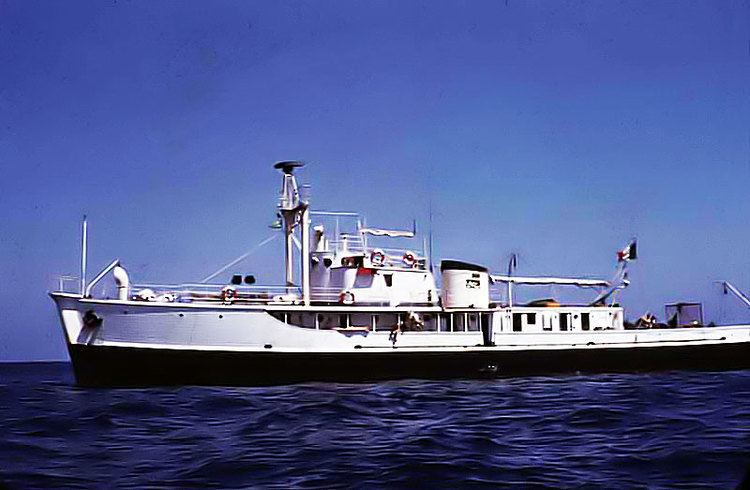
World War II British minesweeper (1941–1947)
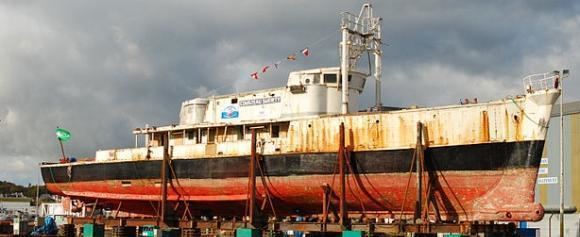
Calypso was originally a minesweeper built by the Ballard Marine Railway Company of Seattle, Washington, USA for the United States Navy for loan to the British Royal Navy under lend-lease. A wooden-hulled vessel, she is built of Oregon pine.
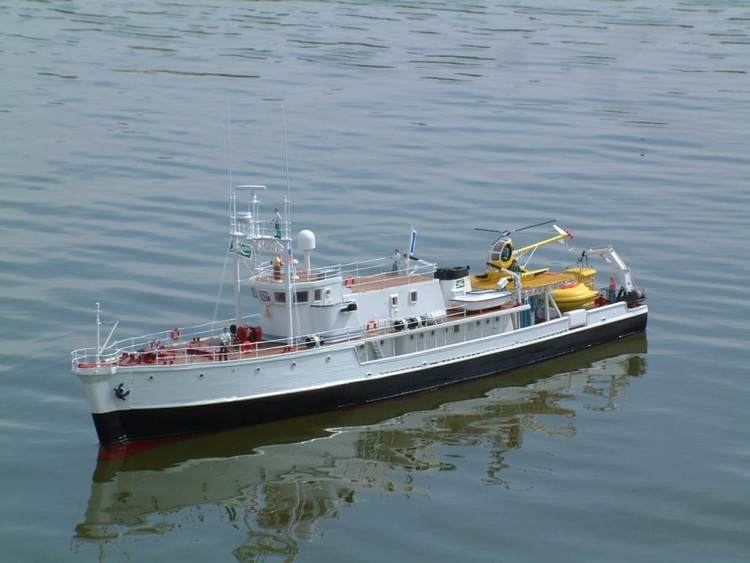
She was a BYMS (British Yard Minesweeper) Mark 1 Class Motor Minesweeper, laid down on 12 August 1941 with yard designation BYMS-26 and launched on 21 March 1942. She was commissioned into the Royal Navy in February 1943 as HMS J-826 and assigned to active service in the Mediterranean Sea, based in Malta, and was reclassified as BYMS-2026 in 1944. Following the end of World War II, she was decommissioned in July 1946 and laid up at Malta. On 1 August 1947 she was formally handed back to the US Navy and then struck from the US Naval Register, remaining in lay-up.
Maltese ferry (1949–1950)
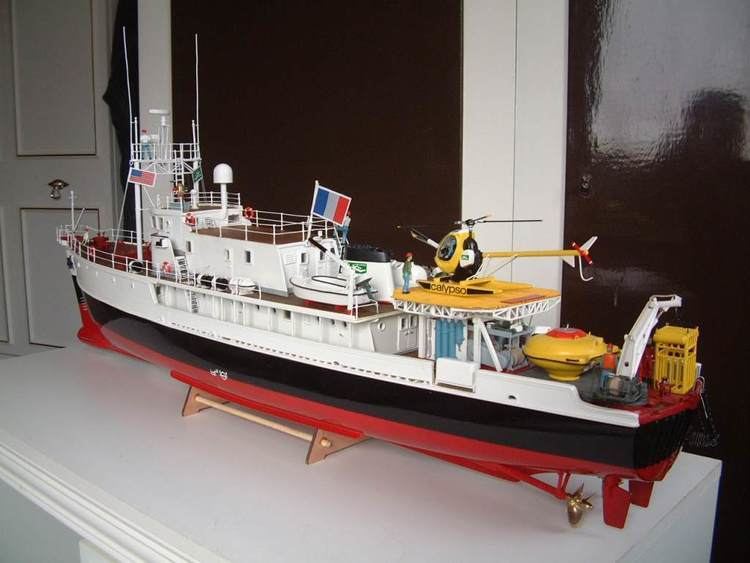
In May 1949 she was purchased by Joseph Gasan of Malta, who had secured the mail contract on the ferry route between Marfa, in the north of Malta, and Mġarr, Gozo in 1947. She was converted to a ferry and renamed Calypso G after the nymph Calypso, whose island of Ogygia was mythically associated with Gozo, entering service in March 1950. After only four months on the route, Gasan received an attractive offer and sold her.
Jacques-Yves Cousteau's Calypso (1950–1997)
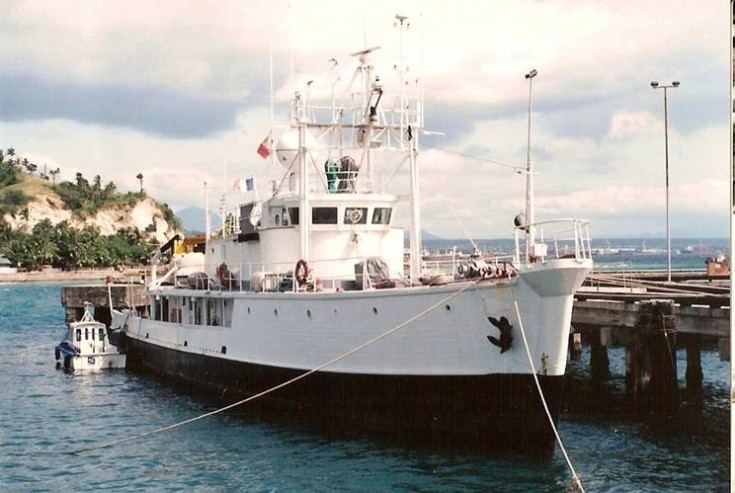
The British millionaire and former MP, Thomas Loel Guinness bought Calypso in July 1950 and leased her to Cousteau for a symbolic one franc a year. He had two conditions, that Cousteau never ask him for money and that he never reveal his identity, which only came out after Cousteau's death. Cousteau restructured and transformed the ship into an expedition vessel and support base for diving, filming and oceanographic research. One of the more unusual expeditions involving the vessel was a survey of Abu Dhabi waters conducted by Cousteau on behalf of British Petroleum in 1954.

Calypso carried advanced equipment, including one- and two-man mini submarines developed by Cousteau, diving saucers, and underwater scooters. The ship was also fitted with a see-through "nose" and an observation chamber 3 metres (9.8 ft) below the waterline, and was modified to house scientific equipment and a helicopter pad. The Calypso underwater camera is named after this ship.
On 8 January 1996, a barge accidentally rammed Calypso and sank her in the port of Singapore. On 16 January, she was raised by a 230-foot (70 m) crane, patched, and pumped dry before being put in shipyard.
The next year, Jacques-Yves Cousteau died on 25 June 1997.
Restoration (1997–present)
Calypso was later towed to Marseille, France, where she lay neglected for two years. Thereafter she was towed to the basin of the Maritime Museum of La Rochelle in 1998, where she was intended to be an exhibit.
A long series of legal and other delays kept any restoration work from beginning. Francine Cousteau, the widow of Jacques Cousteau, managed to organize the ship's restoration. A dispute arose between Francine Cousteau and Loel Guinness, grandson of the original owner.
When this dispute was discovered by the sponsoring Mayor of La Rochelle, it added to the air of uncertainty and hesitancy over funding the restoration. When the mayor subsequently died, the city of La Rochelle withdrew as a source of funding for the restoration. Calypso remained in disrepair.
In 2002, Alexandra, Cousteau's granddaughter from his first marriage, stepped in to help organize restoration. The Cousteau Society, controlled by Francine Cousteau, reportedly spent hundreds of thousands of dollars to defend Francine's exclusive use of the name, and to prevent Alexandra's participation in the restoration of Calypso.
In July 2003, Patrick Schnepp, director of the La Rochelle maritime museum, expressed his frustration at the inability to restore the ship to fit condition: "The whole affair disgusts me... Everything that's not broken is rotten, and everything that's not rotten is broken." The Guardian reported that he desired to see the ship towed off the Île de Ré and scuttled, as Jacques-Yves Cousteau had envisioned would have been the ship's original fate had he not been granted its use.
On 30 November 2004 it was erroneously reported Calypso had been sold by Loel Guinness, to Carnival Cruise Lines. Carnival stated they intended to give the vessel a 1.3 million dollar (1 million euro) restoration, and then likely moor her in the Bahamas as a museum ship.
In late 2006, Loel Guinness transferred ownership of Calypso to the Cousteau Society for the symbolic sum of one Euro. The transfer was part of a plan of restoration led by Francine Cousteau. A legal battle regarding ownership of the vessel ensued which was resolved in favor of the Cousteau Society in October 2007. The restoration project then resumed.
On 11 October 2007, the transfer of the ship to Concarneau started, where she was to be restored at the Piriou Shipyard and transformed into a permanent exhibit.
On 4 October 2008, Swiss watch manufacturer IWC Schaffhausen produced a new luxury chronograph, sold to raise proceeds for the restoration of Calypso.
Restoration work on Calypso stopped in February 2009 after the delivery of Calypso's new engines built by Volvo, because of the non-payment of bills by Francine Cousteau. Piriou sued, claiming to be owed over €850,000, of the estimated total €1,737,000, for work already done on the ship. The ship was stored in one of the ship builder's hangars.
The Cousteau Society filed a counter-suit for defective work. As of March 2009 the Cousteau Society reported that Francine Cousteau was directing the restoration of Calypso as an "ambassador for the seas and oceans". The restoration was to be a complete refurbishment making Calypso a self-powered mobile "ambassador".
In June 2010 the BBC reported that Calypso was to be relaunched to mark the centenary of Jacques Cousteau's birth. However, this 2010 centenary passed without progress.
In September 2013, a petition was launched on change.org that requested that the ship be saved and be added to the French patrimoine national (national heritage). Within three weeks the petition collected 6000 signatures. The Cousteau Society had made a similar request of the French government in 2010. As of October 2013 the Piriou shipyard stated that they expected a resolution from the tribunal de commerce (commercial court) in Quimper within a few weeks, setting the stage for the restoration of the ship by Piriou or another shipyard.
In March, 2015, after a long legal battle, a French court has ordered Francine Cousteau, the second wife of the late Jacques Cousteau, to settle outstanding yard bills of €273,000 and remove Calypso from a Brittany shipyard or the shipyard will be allowed to sell the vessel. On 6 January 2016 the Cousteau Society announced that a solution had been found to allow the ship to return to service, complete with the new Volvo engines.
